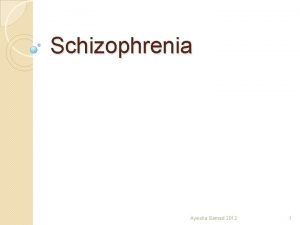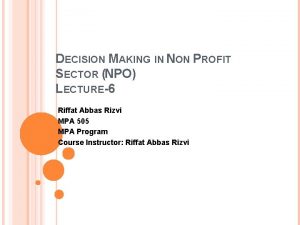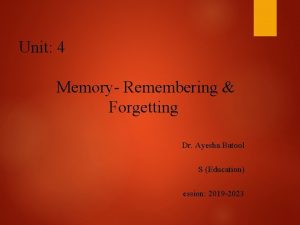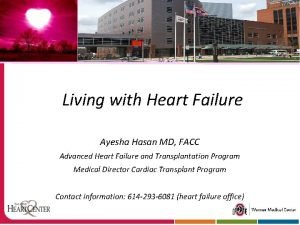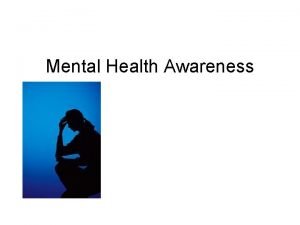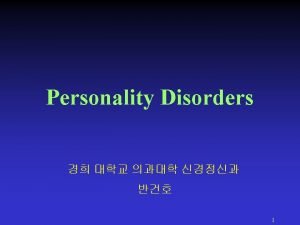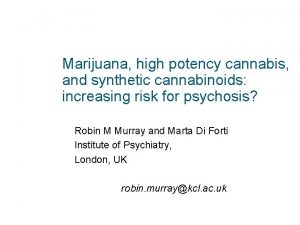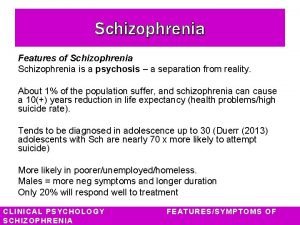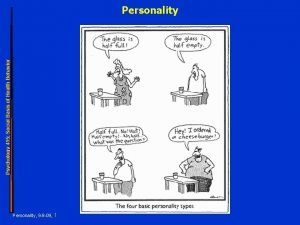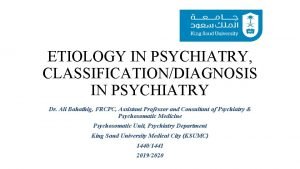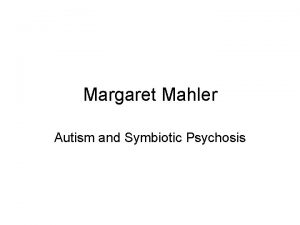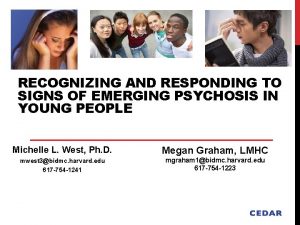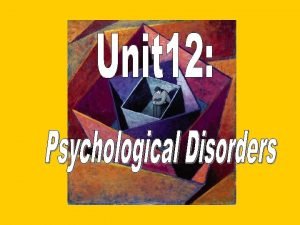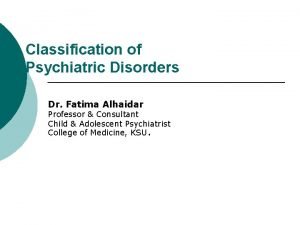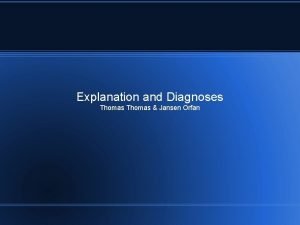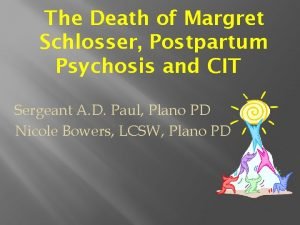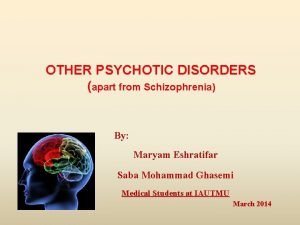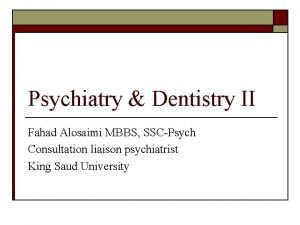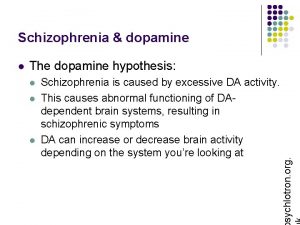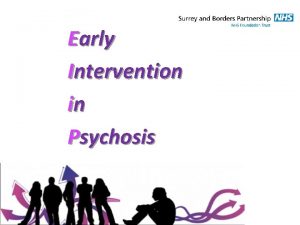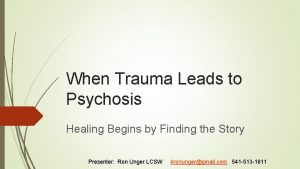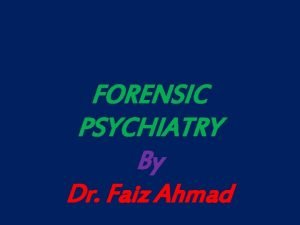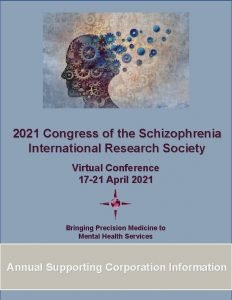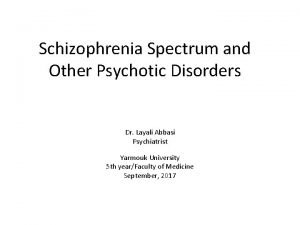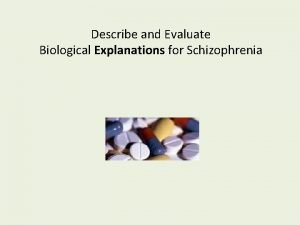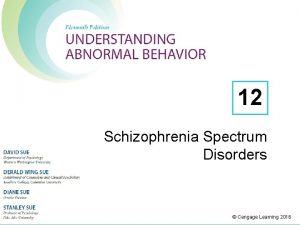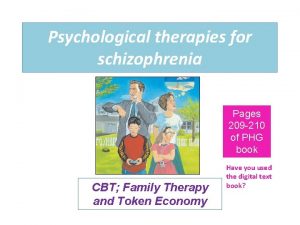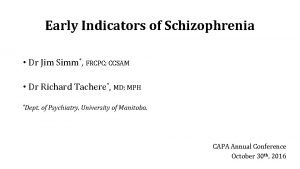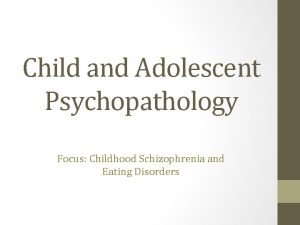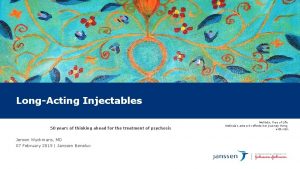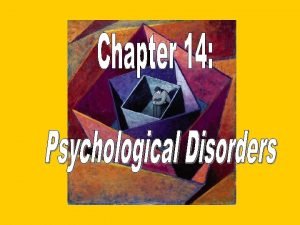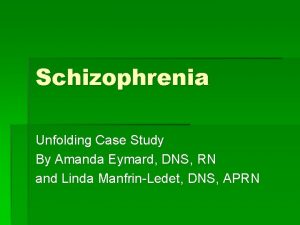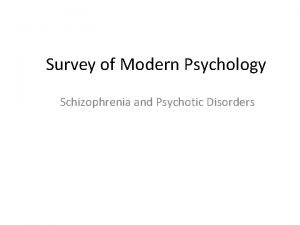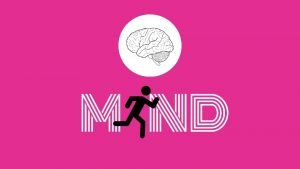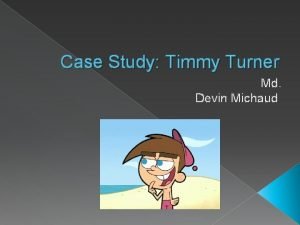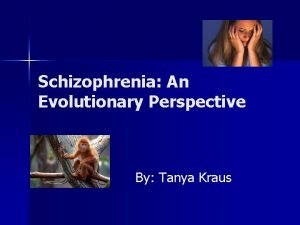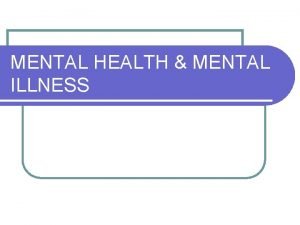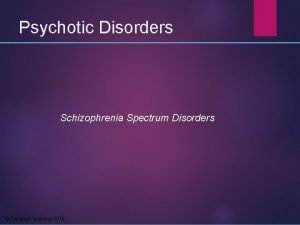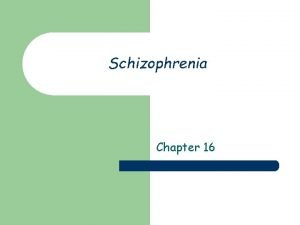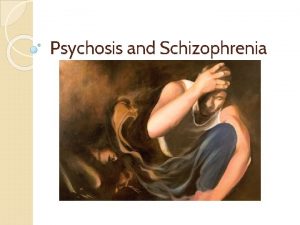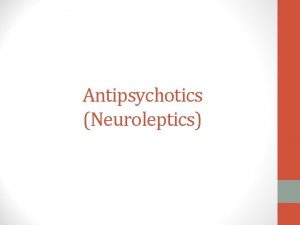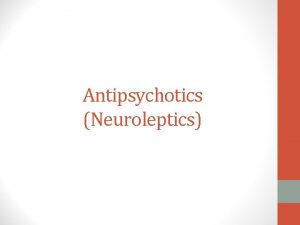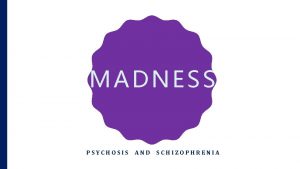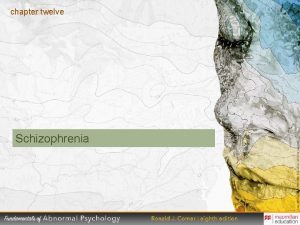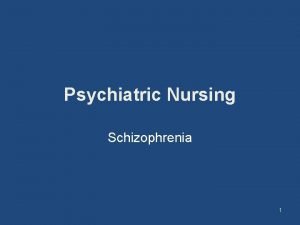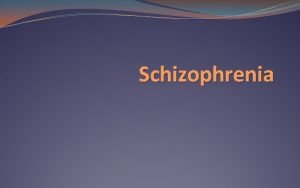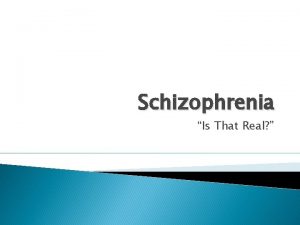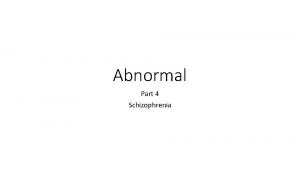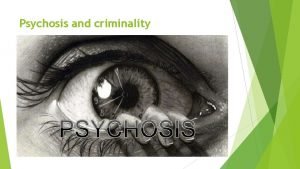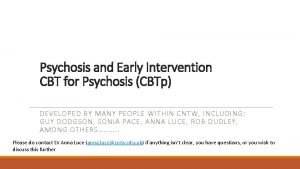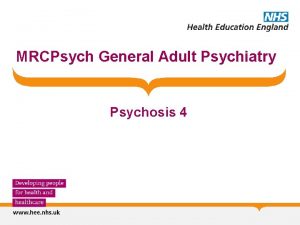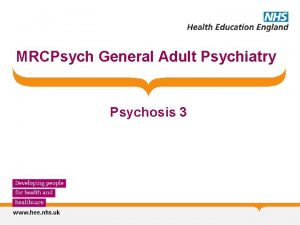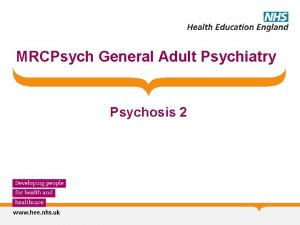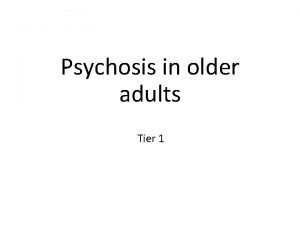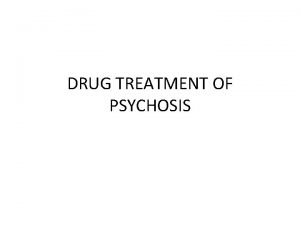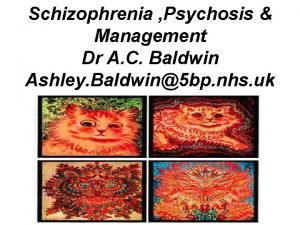Schizophrenia Ayesha Samad 2012 1 Psychosis Psychosis may



















































- Slides: 51

Schizophrenia Ayesha Samad 2012 1

Psychosis �Psychosis may be substance-induced or caused by brain injury, but most psychoses appear in the form of schizophrenia �Psychosis is a state defined by a loss of contact with reality ◦ The ability to perceive and respond to the environment is significantly disturbed; functioning is impaired ◦ Symptoms may include hallucinations (false sensory perceptions) and/or delusions (false beliefs)

Schizophrenia �Schizophrenia appears to have been present in humans throughout history �Schizophrenia affects approximately 1 in 100 people in the world ◦ An estimated 24 million people worldwide are afflicted, 2. 5 million in the US (Comer, 2001) �The financial and emotional costs are enormous ◦ Sufferers have an increased risk of suicide and physical – often fatal – illness

Schizophrenia � Schizophrenia appears in all socioeconomic groups, but is found more frequently in the lower levels ◦ Leading theorists argue that the stress of poverty causes the disorder ◦ Other theorists argue that the disorder causes victims from higher social levels to fall to lower social levels and remain at lower levels �This is called the “downward drift” theory � Equal numbers of men are women are diagnosed ◦ In men, symptoms begin earlier and are more severe � Rates of diagnosis differ by marital status ◦ 3% of divorced or separated people ◦ 2% of single people ◦ 1% of married people

Diagnosing Schizophrenia ◦ The DSM-IV-TR calls for a diagnosis only after signs of the disorder continue for six months or more �People must also show a deterioration in their work, social relations, and ability to care for themselves Ayesha Samad 2012 5

Diagnosing Schizophrenia � The DSM-IV-TR distinguishes five subtypes: 1. Disorganized – characterized by confusion, incoherence, and flat or inappropriate affect 2. Catatonic – characterized by psychomotor disturbance of some sort 3. Paranoid – characterized by an organized system of delusions and auditory hallucinations 4. Undifferentiated – characterized by symptoms which fit no subtype; vague category 5. Residual – characterized by symptoms which have lessened in strength and number; person may continue to display blunted or inappropriate emotions, as well as social withdrawal, eccentric behavior, and some illogical thinking Ayesha Samad 2012 6

Symptoms of Schizophrenia �Symptoms can be grouped into three categories ◦ Positive Symptoms - Pathological excesses or bizarre additions to a person’s behaviour ◦ Negative Symptoms - Pathological deficits or characteristics that are lacking in an individual ◦ Psychomotor Symptoms Ayesha Samad 2012 7

Symptoms of Schizophrenia �Positive Symptoms ◦ Delusions – faulty interpretations of reality 1. Delusions of persecution – most common. People believe they are being plotted or discriminated against, spied on, slandered, threatened, attacked or deliberately victimized. 2. Delusions of reference – attaches special or personal meaning to objects or events 3. Delusions of grandeur – believe themselves to be great inventors, religious saviours or empowered person 4. Delusions of control – believe their feelings, thoughts and actions are being controlled by others Ayesha Samad 2012 8

Symptoms of Schizophrenia �Positive Symptoms ◦ Disorganized Thinking and Speech – also known as formal thought disorders. Can cause sufferers confusion and makes communication difficult 1. Loose associations – rapidly shift from one topic to another 2. Neologisms – made-up words that have meaning only to schizophrenic individual 3. Perseveration – repetition of words and statements again and again 4. Clang – make rhymes Ayesha Samad 2012 9

Symptoms of Schizophrenia �Positive Symptoms ◦ Heightened perceptions and hallucinations – senses are being flooded by all the sights and sounds. ◦ Leads to attention and perception problems resulting in difficulty with memory 1. Auditory Hallucinations – most common kind of schizophrenia. Hearing of sounds and voices that seem to come outside their heads. 2. Somatic Hallucinations – feel like something is happening inside their body 3. Visual Hallucinations – distinct visions or people/objects/colours 4. Gustatory Hallucinations – find that food or drink tastes strange 5. Tactile Hallucinations – tingling, burning or other sensations 6. Olfactory Hallucinations – smells odors that no one Ayesha Samad 2012 10

Symptoms of Schizophrenia �Positive Symptoms ◦ Inappropriate Affect – displaying emotions that are unsuitable or shifts in mood �For e. g. laughing when given some terrible news Ayesha Samad 2012 11

Symptoms of Schizophrenia �Negative Symptoms ◦ Poverty of Speech – also called alogia. A reduction in speech or speech content. ◦ Blunted and Flat Affect – show less anger, sadness, joy and other feelings. Some show almost no emotions with poor eye contact and monotonous voice. �Anhedonia – general lack of pleasure or enjoyment are felt by some ◦ Loss of volition (motivation or directedness) �Feeling drained of energy and interest in normal goals �Inability to start or follow through on a course of action �Ambivalence – conflicted feelings about most things ◦ Social withdrawal �May withdraw from social environment and attend only to their own ideas and fantasies �Seems to lead to a breakdown of social skills, including the ability to accurately recognize other people’s needs and emotions Ayesha Samad 2012 12

Symptoms of Schizophrenia �Psychomotor Symptoms ◦ Awkward movements, repeated grimaces, odd gestures ◦ When taken in extreme forms it is catatonia or Catatonic Schizophrenia 1. Catatonic Stupor – stop responding to their environment. Remain motionless and silent for long stretches 2. Catatonic Rigidity – rigid, upright posture for hours 3. Catatonic Posturing – assume awkward, bizarre positions for long periods of time Ayesha Samad 2012 13

Course of Schizophrenia �Usually appears between the late-teens and early 30 s � 3 Phase ◦ Pro-dormal Phase - schizophrenic symptoms particularly positive symptoms are not obvious. But the person’s ability to function is beginning to deteriorate. Social withdrawal, speaking in odd ways or developing strange ideas. ◦ Active Phase – symptoms become apparent ◦ Residual Phase – active phase symptoms lessen but negative symptoms like blunted affect may remain. �These phases can last for days or for years �Relapses are more likely during times of stress Ayesha Samad 2012 14

Explanations of Schizophrenia �Biological View ◦ Have received the most research support ◦ Looks at how genetics, brain chemistry and brain anatomy contribute to the disorder ◦ Diathesis-stress theory - This model thus assumes that the onset of a certain disorder (or at least episodes of a disorder) results from a combination of one's biological disposition towards the given disorder (or rather traits that may lead to disorders) and stressful events that bring about the onset of a disorder. Nature/Nurture combined. Ayesha Samad 2012 15

Explanations - Biological � Genetics �Some people inherit a biological predisposition to schizophrenia and develop the disorder later in response to extreme stress usually in late adolescence or early adulthood �Relatives – more common among relatives of people with the disorder (Mortenson et al, 1999) Circumstances Probability developing schizophrenia ‘Randomly’ chosen from population 1% 2 nd degree relatives 3% 1 st degree relative 10% 1 parent 16% Both parents 46% �However, you cannot say that genetics is the only factor as these individuals also live in similar environments and it may be the environmental influences that lead to the disorder. Ayesha Samad 2012 16

Explanations - Biological �Genetics �Twins have received particular research study ◦ Gottesman & Shields (1972) examined the records of 57 schizophrenics between 1948 and 1964. About 40% of the twins were determined to be monozygotic (identical) and about 60% dizygotic (fraternal). If the pair were discordant, that is one had schizophrenia and the other did not then the non schizophrenic was followed for at least 13 years to see if it developed later. ◦ Concordance rates, (i. e. probability of a twin having schizophrenia if its twin has the disorder) were as follows: �Monozygotic twins 42% �Dizygotic twins 9% Ayesha Samad 2012 17

Explanations - Biological �Genetics �Twin studies continued �Gottesman (1991) in a review of over 40 other studies found �Monozygotic twins 48% concordance �Dizygotic twins 17% ◦ Heston (1970) found that if one MZ twin has schizophrenia that there’s a 90% probability that the other will have ‘some sort’ of mental disorder! Ayesha Samad 2012 18

Explanations - Biological �So what do the twin studies suggest? ◦ There IS a link to genes and schizophrenia ◦ However, it is not all because of genes otherwise concordance should have been 100% ◦ Hence, environment has some role to play. ◦ Adoption studies were conducted to check whethere is any truth to this statement Ayesha Samad 2012 19

Explanations - Biological � Adoption Studies � Heston (1947) followed 47 children born to schizophrenic mothers but who were separated from them within the first three days of life. � They were adopted into families not related to the biological mothers. � Later in life (30 s) they were compared with a control group of children who had been separated in similar circumstances at birth, but crucially, not born to schizophrenic mothers. � Five of the 47 in the experimental group had gone on to develop schizophrenia (over 10%), whereas none of those in the control group had developed the disorder! Ayesha Samad 2012 20

Explanations - Biological �Adoption Studies �Kety et al (1968) conducted an extensive study in Copenhagen, Denmark �In a sample of 5, 500 adults who had been adopted early in life the found 33 had developed schizophrenia �They then chose 33 matching adults from the same large sample. Matching in terms of age, sex and schooling. �Next they located 365 biological and adoptive relatives of these 66 adoptees including parents and siblings Ayesha Samad 2012 21

Explanations - Biological � Separated the relatives into four groups Biological relatives of adoptees with schizophrenia 14% Adoptive relatives of adoptees with schizophrenia 2. 7% Biological relatives of normal adoptees 3. 4% Adoptive relatives of normal adoptees 5. 5% � Genetic linkage and molecular biology studies indicate that possible gene defects on numerous chromosomes may predispose individuals to develop schizophrenia �These varied findings may indicate: �A case of “mistaken identity” – that is, some of these gene sites do not contribute to the disorder; �Various types of schizophrenia are linked to different genes; or �Schizophrenia, like many disorders, is a polygenic disorder, Ayesha Samad 2012 22 caused by a combination of gene defects

Explanations - Biological � Biochemical Abnormalities • Dopamine Receptors – D-1, D-2, D-3, D-4, D-5 • People with schizophrenia have larger than usual number of dopamine receptors, particularly D-2 receptors. � Dopamine Hypothesis – neurons that use the neurotransmitter dopamine fire too often and transmit too many messages � This is still the foundation for present biochemical insights into schizophrenia � Lowering dopamine activity helps remove or reduce the symptoms of schizophrenia (through antipsychotic drugs also called dopamine antagonists) Ayesha Samad 2012 23

Explanations - Biological �Is there a strong link between dopamine and schizophrenia? ◦ Research on Parkinson’s (low dopamine levels) patients have shown that they develop schizophrenia type symptoms if they take too much of the medication L-dopa. This medication raises dopamine activity so much that it produces psychosis. (Carey et al, 1995) ◦ Support of dopamine hypothesis has also come from research on amphetamines. In the 1970 s researchers saw that those who take high doses of the drug, develop amphetamine psychosis – a symptom similar to schizophrenia. ◦ Amphetamines increase dopamine activity in the brain, thus producing schizophrenic symptoms Ayesha Samad 2012 24

Explanations - Biological �Problems with the dopamine hypothesis �It has been challenged by the discovery of a new type of antipsychotic drug (“atypical” antipsychotics), which are more effective than traditional antipsychotics. These drugs bind not only to D-2 receptors but also to D-1 receptors and to serotonin receptors ◦ Thus, it may be that schizophrenia is related to abnormal activity or interactions of both dopamine and serotonin receptors and perhaps other receptors as well, rather than to abnormal dopamine activity alone ◦ Secondly conventional antipsychotic drugs treat Type I (more positive symptoms) schizophrenia better and atypical antipsychotic drugs treat Type II (more negative symptoms) schizophrenia better. Ayesha Samad 2012 25

Explanations - Biological Abnormal Brain Structure � The brain has four fluid filled spaces that communicate with each other called ventricles. There are two "lateral" ventricles and two midline (the third and fourth) ventricles. Fluid (cerebrospinal fluid) produced within the brain circulates through the ventricles of the brain and around the spinal cord. � Researchers have linked many cases of schizophrenia, particularly Type II schizophrenia, to various abnormalities in brain structure � Patients with schizophrenia have enlarged ventricles. This can be a sign that nearby areas of the brain have not developed properly or have been damaged � Ayesha Samad 2012 26

Explanations - Biological �Abnormal Brain Structure �Studies also suggest that patients with schizophrenia have smaller temporal lobes and frontal lobes �This leads to deficits in attention, language, memory as well as expression Ayesha Samad 2012 27

Explanations - Biological � Viral Problems � Torrey et al, 1997 suggest that brain abnormalities may result from exposure to viruses before birth � These enter the fetus’s brain but remain quiet until puberty or young adulthood when they are triggered by hormonal changes or another viral infection � Studies have shown an unusually large number of patients with schizophrenia born in winter months (Battle et al, 1999) � Mothers of people with schizophrenia were more likely to have been exposed to the influenza virus during pregnancy and specially during the 2 nd trimester � Other studies have found antibodies of pest viruses (usually found in animals) in the blood of 40% of subjects with schizophrenia (Torrey et al, 1994) Ayesha Samad 2012 28

Explanations of Schizophrenia �While genetics, biochemical, brain abnormality and viral findings give an indication to causes of schizophrenia it does not explain how others with these biological abnormalities do not develop the disorder �Hence psychological and sociocultural factors must be present for the disorder to appear Ayesha Samad 2012 29

Explanations - Psychodynamic �While research was being conducted on medical explanations for schizophrenia, the psychological, behavioural and cognitive aspects were largely ignored �Freud (1924) believed that schizophrenia develops out of two tandem psychological processes 1) regression to a pre-ego stage 2) efforts to reestablish ego control �Due to a harsh or an unnurturing environment, people who develop schizophrenia regress to the earliest point in their development, to the pre-ego state of primary narcissism (desire and energy that drives one’s instinct to survive) Ayesha Samad 2012 30

Explanations - Psychodynamic �Years later, psychodynamic clinician Fromm-Reichmann (1948) elaborated on Freud’s notion that cold or unnurturing parents may set schizophrenia in motion. Schizophrenogenic mothers Ayesha Samad 2012 31

Explanations - Cognitive � Cognitive Model � There is widespread agreement that psychosis occurs in people with a vulnerable predisposition (of biopsychosocial origin); that onset often follows life events, adverse environments, illicit drug use, or periods of isolation; that there are emotional changes, and disruptions in cognitive processes of attention, perception, or judgement ; and that, at onset, its most prominent symptoms are delusional beliefs and hallucinations (Garety et al. 2000). � A triggering event gives rise in a predisposed person to a disruption of cognitive processes (Garety & Hemsley, 1994). Ayesha Samad 2012 32

Explanations – Cognitive � � � Frith (1992) in his book called Theory of Mind in Schizophrenia gives “an explanation of these baffling signs and symptoms using the framework of cognitive neuropsychology. There is good empirical evidence that To. M is specifically impaired in schizophrenia and that many psychotic symptoms—for instance, delusions of alien control and persecution, the presence of thought and language disorganization, and other behavioral symptoms—may best be understood in light of a disturbed capacity in patients to relate their own intentions to executing behavior, and to monitor others' intentions. For example, schizophrenic patients can no longer construct representations of their intentions to act. Thus, if actions occur, these will be experienced as coming out of the blue and hence can seem alien. Clinical findings strongly suggest that patients with schizophrenia are impaired in social interaction relating to their reduced capacity to effectively engage in communication (e. g. , Trognon 1992; Sperber and Wilson 2002). Frith (1992) has foremost suggested that To. M in schizophrenia patients is compromised because of their failure to monitor their own and other persons' mental states and behavior, which may account for many positive and negative symptoms in schizophrenic disorders. Patients with prominent negative or disorganized (behavioral) symptoms would accordingly be most impaired in To. M performance, similar to autistic persons, because of their incapacity to represent mental states at all. Patients with paranoid symptoms would perform poorly, relative to healthy control subjects, because of their difficulties in accurately monitoring other people's intentions. Ayesha Samad 2012 33

Explanations - Behavioural � Behaviourists usually cite operant conditioning and the principles of reinforcement as the cause of schizophrenia (Liberman, 1982) � People become more proficient at reading and responding to social cues, i. e. to smiles, frowns etc. � Some individuals, due to unusual circumstances or due to inadequate role models, may not have received these cue. � They then look for other cues in their environment, e. g. a bird flying above, the sound of a word and not it’s meaning. As this increases, their behaviour becomes more and more bizarre. � These bizarre acts are rewarded with attention or other types of reinforcement, and they are likely to be repeated again and again. Ayesha Samad 2012 34

Sociocultural Views �Sociocultural theorists believe that three main social forces contribute to schizophrenia: ◦ Multicultural factors ◦ Social labeling ◦ Family dysfunction �Although these forces are considered important in the development of schizophrenia, research has not yet clarified what their precise relationships might be

Sociocultural Views �Multicultural Factors ◦ Rates of the disorder differ by ethnicity and race �About 2% of African Americans are diagnosed, compared with 1. 4% of Caucasians � It is not clear why this difference exists but one explanation is economic �On average, African Americans are more likely to be poor and, when that factor is controlled for, rates of schizophrenia become closer between the two racial groups �Also consistent with the economic explanation, Hispanic Americans who also are, on average, economically disadvantaged, appear to have a much higher likelihood of being diagnosed than White Americans

Sociocultural Views �Multicultural Factors ◦ Rates also differ between countries, as do the course and outcome of the disorder �Some theorists believe the differences partly reflect genetic differences from population to population �Others argue that the psychosocial environments of developing countries tend to be more supportive than developed countries, leading to more favorable outcomes for people with schizophrenia

Sociocultural Views �Social labeling ◦ Many sociocultural theorists believe that the features of schizophrenia are influenced by the diagnosis itself �Society labels people who fail to conform to certain norms of behavior �Once assigned, the label becomes a self-fulfilling prophecy ◦ The dangers of social labeling have been well demonstrated �Example: Rosenhan “pseudo-patient” study

Sociocultural Views � Family dysfunctioning ◦ A number of studies suggest that schizophrenia is often linked to family stress: �Parents of people with the disorder often: �Display more conflict �Have greater difficulty communicating �Are more critical of and overinvolved with their children than other parents �Family theorists have long recognized that some families are high in “expressed emotion” – family members frequently express criticism and hostility and intrude on each other’s privacy �Individuals who are trying to recover from schizophrenia are almost four times more likely to relapse if they live with such a family

Treatment � Historical Perspective ◦ For more than half of the 20 th century, most people with schizophrenia were institutionalized in a public mental hospital ◦ The primary goals of these establishments were simply to restrain them and provide them with the most basic necessities – food, shelter and clothing. ◦ Patients rarely saw therapists and were largely neglected. ◦ In 1793, a French physician Philippe Pinel began the practice of ‘morale treatment’ and set up mental hospitals rather than asylums ◦ This concept became popular in the U. S. also and state hospitals were set up. ◦ However, in 110 years (1845 -1955) the number of patients increased from 2, 000 to 300, 000 leading to over crowding and a sharp decline in the quality of care. ◦ During this time (in 1949) the Nobel Prize was won by Hess and Moniz for the miracle breakthrough of ‘labotomy’ a surgery that drilled two holes on either side of the skull and inserted an instrument to destroy nerve fibers. ◦ Today, this surgery is not used and later studies revealed that lobotomies cause serious problems such as brain seizures, huge Ayesha Samad 2012 40

Treatment - Biological �Because most of the research in schizophrenia has focused on the biological model, the primary treatment for schizophrenia is biological ◦ The biological treatment of schizophrenia can be divided into 3 components: 1. The use of typical antipsychotics – drug therapy 2. The use of atypical antipsychotics – drug therapy 3. ECT (Electro-convulsive therapy) Ayesha Samad 2012 41

Treatment - Biological � Typical antipsychotics (example : chlorpromazine, haloperidol) ◦ Typical antipsychotic drugs belong to first generation antipsychotics. ◦ They work by blocking the dopamine receptors in the brain (specially D-2 receptors) ◦ Typical antipsychotic medications are most effective in treating positive symptoms such as hallucinations and delusions. ◦ Although some patients may improve after only a week or two of treatment, the most complete effects of these medications are usually seen after six to eight weeks. ◦ Some patients experience extra-pyramidal side effects (EPS), which are uncontrollable bodily movements such as muscle spasms or shaking. In this Parkinsonian type symptoms are the most common. Other medications can be used to minimize extrapyramidal side effects, although the relief is only temporary. ◦ In fact, studies have shown that patients who take typical antipsychotic medications for 10 years or more may develop a serious condition called tardive dyskinesia in which patients experience involuntary movements of the tongue, lips, and neck. Ayesha Samad 2012 42

Treatment - Biological � Atypical antipsychotics (example: clozapine) ◦ In the 1980 s, researchers focused on developing medications that treated more aspects of schizophrenia and did so without disabling side effects. These medications that are used frequently today are called atypical antipsychotic medications, or secondgeneration antipsychotics. ◦ Unlike early antipsychotic medications, atypical antipsychotic medications are effective at treating both positive and negative symptoms. ◦ Researchers speculate that traditional antipsychotic medications completely block one kind of dopamine receptor, leaving other types of dopamine receptors unaffected. Atypical antipsychotics appear to block many kinds of dopamine receptors less completely (D-1 and D-2) and some serotonin receptors. ◦ So why use typical antipsychotics when atypical ones are present? Because atypical meds block several receptors, which indicates a higher chance of lowering dopamine levels ◦ Atypical antipsychotics have fewer unwanted effects, specially few extrapyramidal symptoms and do not produce tardive dyskinesia. However, in 1 to 2% of the cases a life threatening reduction in white blood cells takes place, hence, regular blood tests is imperative. Ayesha Samad 2012 43

Treatment - Biological � ECT ◦ It's extremely rare for patients with schizophrenia to be offered ECT. Although ECT was developed as a schizophrenia treatment, it turns out that ECT is significantly more effective in treating other mental illnesses. It has the most effect on people who are badly depressed, or who are having a catatonic or manic episode. ◦ Although its use in schizophrenia is rare, ECT might help people with schizophrenia who have a concurrent mood disorder, or who are unresponsive to antipsychotic drugs. ◦ The goal of ECT is to induce a seizure by running a carefully controlled current of electricity through the patient's brain. The seizure lasts for at least 30 seconds. The seizure affects brain activity, but scientists are not exactly sure how or why this works to control the symptoms of mental illness. One hypothesis however, is that it works by altering the shape of dopamine receptors. ◦ Most people are given ECT every two to five days for a total of 6 to 12 sessions. After the sessions are complete, a course of medication can help maintain remission of symptoms. ◦ Headaches, confusion, and memory loss are the most common side effects that patients experience as they awaken from anesthesia. The duration of these effects vary from person to person, lasting from a few minutes to a few hours. Ayesha Samad 2012 44

Treatment - Psychotherapy �Before the discovery of antipsychotic drugs, psychotherapy was not really an option for people with schizophrenia. �Therapists believed that the first task of such therapy was to win the trust of patients and build a close relationship with them. �Today psychotherapy is successful in many more cases with the assistance of antipsychotic drugs. �Psychotherapy may be of little help during the earliest stages of treatment, it apparently becomes useful later on, particularly after medications have made an impact. Ayesha Samad 2012 45

Treatment - Psychotherapy �Types ◦ Family therapy – works with family, parents, siblings, spouses or children. Helping them cope with the situation by providing emotional support, practical advice and traning. Also, educating them about not being overly critical, having a more positive environment. ◦ Social therapy – clinicians offer practical advice, work with clients on problem solving, decision making and social skills. Research finds that social therapy does help keep patients with schizophrenia out of the hospital. Ayesha Samad 2012 46

Treatment - Behavioural �Token Economy Programs (Ayllon, 1963) ◦ Patients are rewarded when they behave acceptably and are not rewarded when they behave unacceptably. ◦ Typically, the immediate reward for acceptable behaviour is a token that can later be exchanged for food, cigarettes, hospital privileges etc. Acceptable behaviour likely to get tokens are taking care of oneself, speaking coherently, Ayesha Samad 2012 47 following rules etc.

Treatment - Behavioural �Paul and Lentz (1977) set up a hospital taken economy for 28 patients with schizophrenia, most of improved greatly. �After 4. 5 years, 98% of the subjects had been released, mostly to sheltered-care facilities, compared with 71% of patients treated in a milieu program and 45% of patients who received custodial care only. Ayesha Samad 2012 48

Treatment - Behavioural �Limitations of Token Economy ◦ Changes in the physical setting e. g. staff attention could be causing patient improvements rather than token economy itself. ◦ Is behaviour changing due to token economy or is the program only improving the patient’s ability to imitate normal behaviour? Are the symptoms changing or are patients responding in a way that is expected? ◦ Can effects of token economy last in real life settings? What happens when patients are released from hospital in their normal settings? Ayesha Samad 2012 49

Treatment - Cognitive-behavioral therapy (CBT) in schizophrenia was originally developed to provide additional treatment for residual symptoms, drawing on the principles and intervention strategies previously developed for anxiety and depression. In the 1950 s, Aaron Beck 1 had already treated a psychotic patient with a cognitive approach, but thereafter the research in this specific area lay dormant for decades. Only after cognitive therapy had been firmly established for depression and anxiety, in the 1990 s, did the research into psychological treatments for psychotic conditions gather force— again, with Beck in the forefront. � Pharmacologic therapy can leave as many as 60% of psychotic patients with persistent positive and negative symptoms, even when the patients are compliant with their medication instructions. 2 Furthermore, medication compliance remains a major problem despite the introduction of modern atypical antipsychotics. Studies have shown treatment discontinuation in an estimated 74% of patients in both outpatient and inpatient settings. 3 � CBT is now recognized as an effective intervention for schizophrenia in clinical guidelines developed in the United States 9 and in Europe. 10 In spite of the evidence base and absence of side effects, however, the general availability of this treatment approach within community settings is still low. � Ayesha Samad 2012 50

Treatment - Cognitive � � � � Sensky (2000) A randomized controlled design was used to compare the efficacy of manualized cognitivebehavioral therapy developed particularly for schizophrenia with that of a nonspecific befriending control intervention. Both interventions were delivered by 2 experienced nurses who received regular supervision. Patients were assessed by blind raters at baseline, after treatment (lasting up to 9 months), and at a 9 -month follow-up evaluation. Patients continued to receive routine care throughout the study. Ninety patients received a mean of 19 individual treatment sessions over 9 months, with no significant between-group differences in treatment duration. Both interventions resulted in significant reductions in positive and negative symptoms and depression. At the 9 -month follow -up evaluation, patients who had received cognitive therapy continued to improve, while those in the befriending group did not. Patients were recruited into the study from 5 clinical services: 2 in West London and 3 in the north of England (one each in Newcastle, Cleveland, and Durham). Patients were included if they were aged 16 to 60 years; and had symptom(s) causing distress and/or dysfunction that had persisted for at least 6 months despite adequate trials of antipsychotic medication. Informed consent was obtained. Cognitive-behavioral therapy is effective in treating negative as well as positive symptoms in schizophrenia resistant to standard antipsychotic drugs, with its efficacy sustained over 9 months of follow-up. Patients received individual treatment from 1 of 2 therapists (M. O. and R. S. ). One therapist was based at each study center, and each offered CBT or BF, according to the patient's assigned group. Both CBT and BF resulted in significant symptom improvements at the end of the treatment period. At the end of treatment, there were no significant differences between the 2 interventions. However, at 9 -month follow-up, CBT resulted in significantly greater improvements than BF for all 4 outcome measures. Between outcome and follow-up evaluation, those in the CBT group continued to show improvements, while those in the BF Ayesha Samad 2012 51 group lost some of their earlier gains.
 Ayesha samad
Ayesha samad Perpustakaan sultan abdul samad
Perpustakaan sultan abdul samad Samad hayati
Samad hayati Perpustakaan sultan abdul samad
Perpustakaan sultan abdul samad Dr ayesha anwar
Dr ayesha anwar Dr ayesha ghous pasha
Dr ayesha ghous pasha Description of taiga
Description of taiga Dr ayesha batool
Dr ayesha batool Scapulohumeral rhythm
Scapulohumeral rhythm Ayesha hasan md
Ayesha hasan md Types of psychosis and neurosis
Types of psychosis and neurosis Functional psychosis
Functional psychosis Geiteams
Geiteams Types of delusions
Types of delusions Psychosis
Psychosis Types of psychosis and neurosis
Types of psychosis and neurosis Infantile autism
Infantile autism Neurosis vs psychosis
Neurosis vs psychosis First episode psychosis
First episode psychosis Mild psychosis
Mild psychosis Psychosis
Psychosis Psychiatric disorders
Psychiatric disorders Psychosis traduction
Psychosis traduction Margaret schlosser crime scene
Margaret schlosser crime scene Culture bound syndrome
Culture bound syndrome Fahad alosaimi
Fahad alosaimi Dopamine hypothesis psychosis
Dopamine hypothesis psychosis Psycosis
Psycosis Psychosis and ptsd
Psychosis and ptsd Ictal phase
Ictal phase What is forensic psychiatry
What is forensic psychiatry Hci design patterns
Hci design patterns Sirs congress 2021
Sirs congress 2021 Schizophrenia dsm 5
Schizophrenia dsm 5 Biological explanations of schizophrenia
Biological explanations of schizophrenia Is schizophrenia on a spectrum
Is schizophrenia on a spectrum Two years ago jenny was diagnosed with schizophrenia
Two years ago jenny was diagnosed with schizophrenia Jim simm
Jim simm Example of loose associations in schizophrenia
Example of loose associations in schizophrenia Progressive disease
Progressive disease Strengths and weaknesses of psychodynamic theory
Strengths and weaknesses of psychodynamic theory Acute schizophrenia
Acute schizophrenia Thesis statement on schizophrenia
Thesis statement on schizophrenia Schizophrenia unfolding case study answers
Schizophrenia unfolding case study answers Delusional disorder
Delusional disorder What causes schizophrenia
What causes schizophrenia Was timmy turner schizophrenia
Was timmy turner schizophrenia Tanya kraus
Tanya kraus Axis 1-5 mental health
Axis 1-5 mental health Phases of schizophrenia
Phases of schizophrenia What is schizophrenia
What is schizophrenia Schizophrenia disorganized behavior
Schizophrenia disorganized behavior
